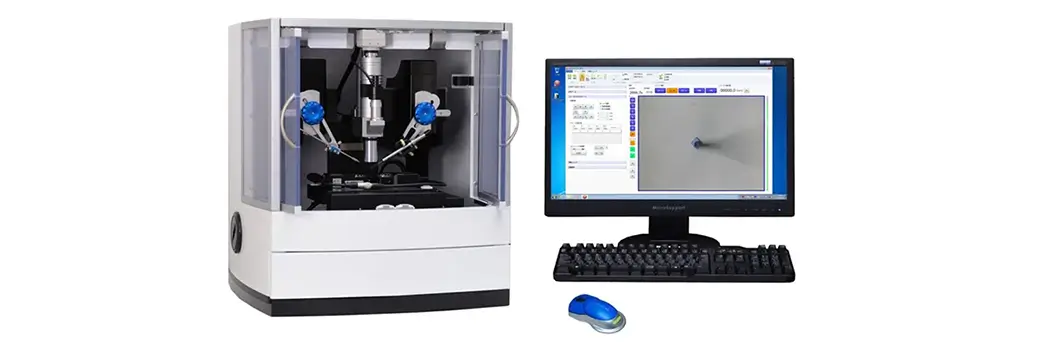Exploring Micromanipulators: Unveiling the Microscopic World

Micromanipulators are essential tools to handle microscopic objects in various industries, including semiconductors, electronics, chemicals, and material science. These revolutionary devices have paved the way for precise and accurate micro-sample handling, research, and analysis of minute entities. Among them, micromanipulators are particularly notable as they can move along the X, Y, and Z axes. This post discusses micromanipulators, their applications, and their significant impact on various sectors.
Overview of Micromanipulators
A micromanipulator enables precise interaction with microscopic samples or entities. It allows for accurate mounting and movement of various sampling tools like pipettes, probes, and electrodes. When integrated with a microscope, it provides the ability to view and manipulate various dimensions and cross-sections of magnified objects by physically turning, bending, or cutting the sample. Their basic functions may include collecting liquid droplets, removing surface contaminants, retrieving particles stuck to adhesives, and many more delicate tasks under the microscope. One can control their movements along all three axes using a mouse.
Basic Design
A micromanipulator system comes with a controller, display screen or computer, mouse, probe arms, and advanced software for management and control. You may also require other accessories such as rod or pipette holders, tungsten probes, micro-knives, tweezers, and a mounting system or stage. Mounting on a stable surface helps reduce vibration and ensure precision. While this tool can be controlled manually, a motorized control is always preferred through a joystick or mouse. Motorized control enables a high level of precision and control which allows movements in micrometer and nanometer ranges. The three axes of micromanipulators facilitate movement in various directions. The X-axis facilitates left to right and vice-versa movements, Y-axis enables forward and backward movements, and Z-axis enables vertical or up and down movements. The dimensions and distance of movement depend on each model.
Axes and Movement Control in Micromanipulators
A manipulator enables precision and accuracy when sampling and manipulating microscopic entities. The way it moves along the three axes, the angles, and the maximum distance are significant factors in manipulation tasks. Primarily, it moves along the three perpendicular axes. The X-axis movements help position the object well in place. The Y-axis movement helps adjust the object’s distance from the user to view finer details. The Z-axis movement helps adjust the height of the object. While mouse and software are highly preferred to control movements, some models may have piezoelectric actuators. The arms can travel around 10-50 meters on an average along the axis. You can also create a synthetic diagonal movement along the X and Y axis. All of these movements enable the micromanipulator system to carry out its basic functions such as sampling, sorting, and so on.
Advantages of Using Micromanipulators Over Traditional Manipulation Tools
The obvious benefit of using a micromanipulator system is precision movement during sampling and manipulation. Here are some other advantages.
- Precision: Enables precise actions such as holding, cutting, removing, transferring, injecting, and applying patches or coatings to objects as small as two to five microns.
- Real-Time Feedback: Features feedback systems and sensors that provide real-time information on positions and movements.
- Integration: Easily integrates with microscopes, cameras, and research equipment, enhancing functionality and accuracy.
- Automation: Can be fully or partially automated and programmed for repeatable tasks.
- Enhanced Visualization: Improves the visualization of objects under the microscope, aiding detailed observation.
- Safety and Operability: Fully covered electric micromanipulator systems offer high levels of safety and operability.
- Remote Functionality: Some models can be operated remotely within a glovebox using a mouse.
- Customization: Can be customized to accommodate tall samples or large objects with adjustable base heights.
Applications of Micromanipulators
These micromanipulators are used in a wide range of applications, including:.
- Failure Analysis: Micromanipulators can be used to precise isolate particles and other failures in manufacturing to quickly determine the root cause of failure.
- Electronics and semiconductors: Micromanipulators enable fine markings on wafers, fiber glass and metal circuit boards, and more. They are also used for positioning components on circuit boards, soldering, testing, and more.
- Material science: Micromanipulators are used to separate materials from their substrates or adhesives, identify material properties under a microscope, and manipulate nanoparticles for further research.
- Scientific research: Micromanipulators are used in biological research, fertility treatments and analysis, and biological cell manipulation. They are used in electrophysiology to position electrodes and record activity from neurons or nerve cells.
- Micromanufacturing and fabrication: These tools are used in additive manufacturing methods such as 3D printing, and assembling tiny parts into complex microdevices.
- Pharmaceutical: They are used in single-cell analysis and drug delivery at the cellular level to position micropumps and needles.
- Optics: They are used in optical systems for precise adjustment and focusing of lenses.
- Criminalistics: These systems are used in the microanalysis of fine particles, hair strands, and so on to handle samples that may serve as evidence in investigations.
Micromanipulator systems are gaining traction across an increasing number of industries. Using these for sampling and manipulation would definitely yield excellent end results. If you have any questions about using these tools in your application, custom options, and more, you can consult Barnett Technical Services, an authorized distributor of Micro Support’s micromanipulators
Related Products:
Axis Pro : Benchtop micromanipulator incorporating a zoom microscope and motorized sampling arms.
Quick Pro : Individual micromanipulator arm that can be added to a white light microscope.
Collection Pro : Automated grain/particle sorting and collection system.
